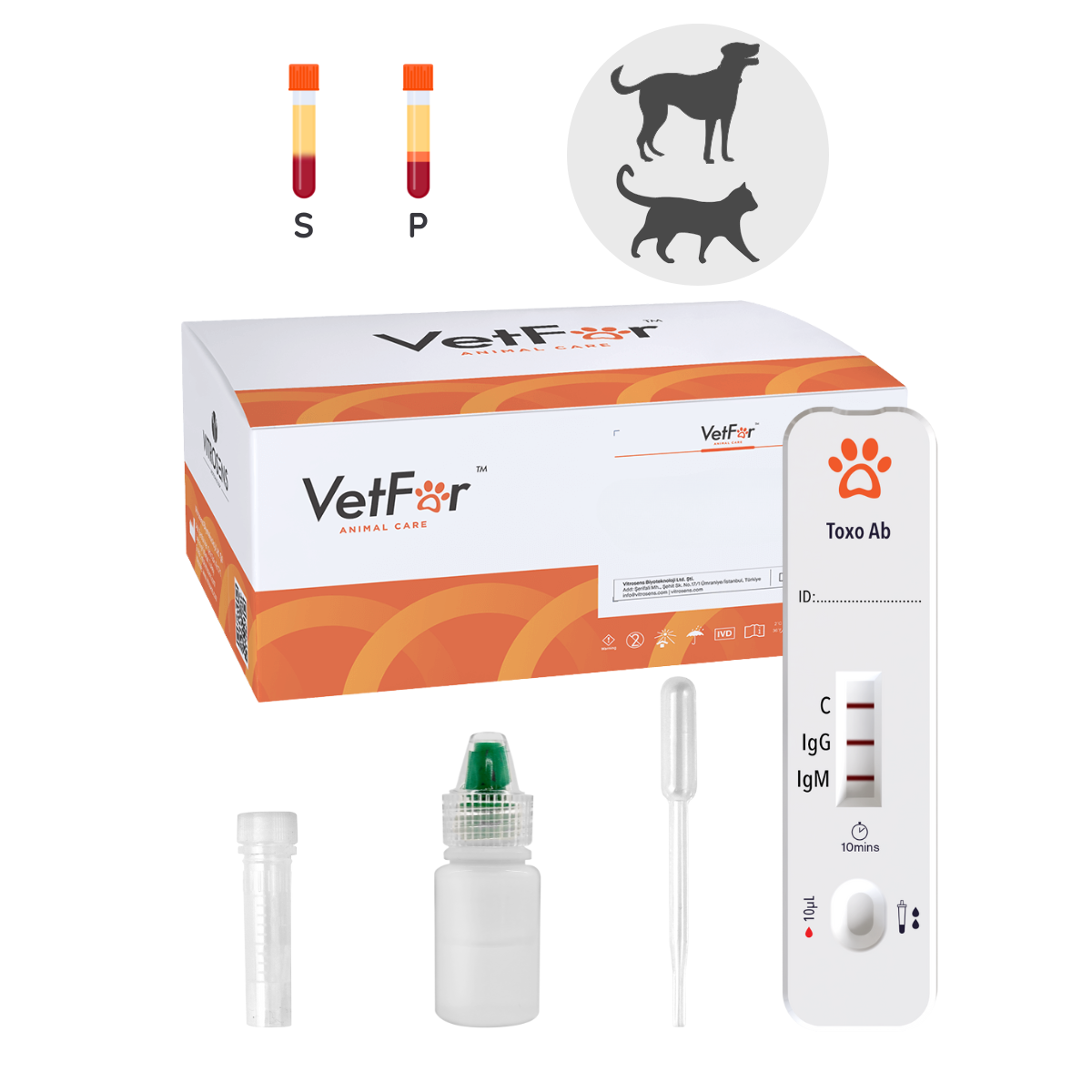Toxoplasma Antigen Test
This rapid test is intended for the rapid detection of specific antibodies against Toxoplasma gondii in serum or plasma samples from dogs and cats.
56,50 €
| Quantity | Price | Discount |
|---|---|---|
| 3-5 | 54,81 € | 3% |
| 6-9 | 53,11 € | 6% |
| 10+ | 50,85 € | 10% |
| Sample type |
Plasma ,Serum |
|---|---|
| Target specie |
Canine (Dog) ,Feline (Cat) |
| Target |
Toxoplasma (dog & cat) |
| Packaging unit |
10 Tests |
| Sensitivity |
> 98% |
| Specificity |
100% |
The VetFor™ Toxo Rapid Test is a lateral flow sandwich test for the qualitative detection of antibodies against Toxoplasma gondii (Ab) in serum or plasma samples from dogs and cats. The test kit contains all the necessary components to perform a simple and accurate test and is intended exclusively for in vitro veterinary diagnosis by a professional.
Product details
Test type: Lateral sandwich immunoassay
Target parameter: Antibodies against Toxoplasma gondii
Sample material: Serum or plasma samples from dogs and cats
Result time: Rapid test with direct evaluation after 10 minutes
Limit of detection: 1/16 dilution of the standard (IFA titer 512)
Cross-reactivity: No cross-reactivity detected with the following pathogens at a 1:16 dilution of the standard: Feline Coronavirus (FCV), Feline Herpesvirus (FHP), Feline Hookworm (FHW), Feline Leukemia Virus (FeLV), Feline Parvovirus (FPV)
Storage conditions: 2 – 30 °C
Performance data
Toxo (Feline)
-
Sensitivity: 98,21 %
-
Specificity: 100,0 %
-
Accuracy: 99,13 %
Toxo (Canine)
-
Sensitivity: 98,46 %
-
Specificity: 100,0 %
-
Accuracy: 99,13 %
Content
- 10 test cassettes (1 test/bag)
- 10 disposable plastic droppers
- 10 tubes with EDTA
- 2 bulk bottles with diluent
- 1 instruction manual
For professional use only!
SHELF LIFE AND STORAGE
- The test kit must be stored at a temperature between 2 °C and 30 °C and a relative humidity of 40% to 60%. All components must be brought to room temperature before testing.
- Do not open sealed pouches and test kits until immediately before use.
- The test is stable until the expiration date. Do not use the test kit after the expiration date. The expiration date is indicated on the label/packaging of the sealed foil pouch.
- Do not expose the test kit to direct sunlight.
NOTES
- For in vitro diagnostic use only.
- For optimal test results, the manufacturer's instructions should be followed precisely.
- The tests should be conducted in compliance with biosafety measures and with protective clothing.
- The test kits must be kept in their sealed packaging until use.
- Do not use the test kit if the pouch is damaged or the seal is broken.
- The components of the test kit must not be reused.
- All components must be brought to room temperature before testing.
- The test kit may only be used up to the indicated expiration date.
- The components of this test kit have been tested as a standard batch.
- Do not exchange or mix components from different test kits.
- Do not touch the uncovered areas of the membrane in the test cassette.
- Inadequate or incorrect sample collection as well as improper storage and transport conditions may falsify the test results.
- All components of the test kit should be disposed of as infectious material.
You must be logged in to post a review.
Expert Knowledge on Toxoplasma in Dogs and Cats
Toxoplasma gondii is a single-celled parasite that uses cats as definitive hosts, while dogs often serve as intermediate hosts. In cats, infection often occurs without symptoms. In dogs, symptoms vary depending on the affected organ and may include fever, coughing, breathing difficulties, diarrhea, vomiting, jaundice, eye inflammation, myocarditis, and neurological abnormalities.
Transmission and Epidemiology
After infection with Toxoplasma gondii, cats excrete oocysts in their feces. These oocysts become infectious in the environment and can be ingested by other animals or humans. Dogs typically become infected by consuming raw or undercooked meat from infected animals.
Diagnosis
Diagnosis is made through serological tests that detect specific antibodies against Toxoplasma gondii. In suspected acute infections, additional tests such as fecal antigen detection may be performed.
Treatment
In symptomatic infections, antibiotics such as clindamycin are used to eliminate the parasites and relieve symptoms. In asymptomatic animals, treatment is generally not necessary.
Prevention
-
For cats:
-
Avoid feeding raw or undercooked meat.
-
Clean the litter box regularly, ideally daily, to minimize oocyst shedding.
-
Keeping cats indoors can reduce the risk of infection.
-
-
For dogs:
-
Feed only thoroughly cooked or properly heated meat.
-
Avoid access to potentially contaminated food or water sources.
-
Following basic hygiene practices, such as regular hand washing after handling animals or their waste, can reduce the risk of infection for both animals and humans.
References:
- ESCCAP Germany. (n.d.). Toxoplasmosis in Cats: Transmission and Prevention. Available at: https://www.esccap.de/parasiten/einzeller
- Royal Canin. (n.d.). Toxoplasmosis in Cats. Available at: https://vetfocus.royalcanin.com/de/wissenschaft/toxoplasmose-bei-katzen
- Tiermedizinportal. (2023). Toxoplasmosis in Cats: Symptoms and Treatment. Available at: https://www.tiermedizinportal.de/tierkrankheiten/katzenkrankheiten/toxoplasmose-bei-der-katze
- Focus Tierarzt. (2022). Toxoplasmosis in Cats: Symptoms and Risk of Infection. Available at: https://focus-tierarzt.de/magazin/toxoplasmose-bei-katzen-symptome-und-ansteckungsgefahr
translated from German version





Reviews
Clear filtersThere are no reviews yet.